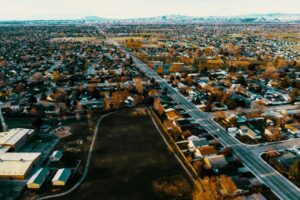Larry Silverstein Talks Rebuilding, Resilience at the World Trade Center

Larry Silverstein has seen New York City and its commercial real estate through nearly 70 years of ups and downs, both literally and figuratively contributing to its rebuilding.
In a Q&A discussion surrounding The Rising, a recently published memoir detailing the two-plus-decade long rebuilding of the World Trade Center, the Manhattan mogul, president & CEO of his namesake company, expressed both his pride in what has already been built and his optimism about the city’s future.
Five of the campus’ planned seven buildings alongside Lower Manhattan are complete and 97 percent leased. The development remains one of The Big Apple’s largest hubs of commerce, arts and culture.
“I’ve lost my sense of objectivity,” Silverstein said at the discussion, which took place at the first-to-be-rebuilt 7 World Trade Center. “As I look out the window and I see what we’ve accomplished, (I think) we’ve done a reasonably good job,” Silverstein added.
Bullish near the bull’s domain
The process of building glass towers from rubble, memorializing the victims of the attacks and revitalizing the area was not without its hardships, tangled in a web of competing of public and private interests. Over the decades, they ranged from replacing a destroyed Con Edison electric substation to a five-year battle with 22 separate yet equally unwilling insurance companies over more than $4 billion worth of payouts for the destroyed buildings and infrastructure. Even now, the future 2 World Trade Center remains without an anchor tenant.
Outside of this, around the time of its rebuilding, the neighborhood was having an identity crisis, being seen as nearly the exclusive domain of stockbrokers and office workers, with many reservations about the area’s safety in light of the attacks.
“At that time, if you came there on a Saturday or Sunday, you could roll a bowling ball down Wall Street,” Silverstein reflected. Such past and present difficulties are compounded by the fact that much of the area’s existing office stock was built in the 1970s and ’80s, with their obsolescence hastened by the pandemic and subsequent takeover of hybrid work. “These buildings today no longer have the needs of their occupants,” Silverstein noted.
READ ALSO: Manhattan Office Visits Up Year-Over-Year: REBNY
In Silverstein’s mind, developers have two options. Either build out easily accessible, aesthetically and functionally appealing office spaces, or convert existing stock to residential. Silverstein happens to be engaging in both acts. Last year, the firm bought 55 Broad St., a 30-story office tower built in 1967, with plans to develop more than 500 apartments. As for what that bowling alley looks like now, “the area between Broad and Water Streets is residential,” Silverstein detailed.
Remembering the roots
When asked about the city’s political climate and latent struggles with housing costs, Silverstein’s reply mirrored much of his responses to the struggles with rebuilding. That New York City is above any hardship, be it a financial crisis, pandemic or terror attack, and that having a worthy goal is more important than having enough capital or agreeable partners to help one achieve it.
“I’ve been here all my life, working since (1956). It’s given me an opportunity to work my tail off. If (the city) did not provide those opportunities to me, I would have had a totally different life,” Silverstein reflected.
The post Larry Silverstein Talks Rebuilding, Resilience at the World Trade Center appeared first on Commercial Property Executive.




